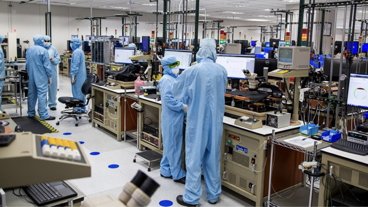Corroborating the findings Appleinsider published at the beginning of April, a new report by IEEE's Spectrum indicates that Apple did indeed buy Intrinsity to speed up the design of ARM chips used in its mobile devices.
While there has been speculation that Apple designed the A4 in-house using either its own ASIC design team or the expertise it acquired from PA Semi, the report notes that "designing a CPU usually takes two to three years—making it unlikely that the PA Semi engineers created the iPad chip in the time they’ve been with Apple."
Additionally, the report cited market analyst Will Strauss of Forward Concepts in Tempe, Arizona as pointing out that Qualcomm spent three years and $300 million developing "Snapdragon," an ARM Cortex A8 processor design capable of running at 1GHz. The standard Cortex A8 design can only be clocked up to 650MHz.
"There’s nothing in the quarterly statements from Apple indicating they spent that kind of money or time" to develop a similarly fast, independent version of the Cortex A8 design.
The only other company with chip acceleration technology similar to Qualcomm's was Intrinsity, which dubbed its version of the Cortex A8 capable of running at 1GHz "Hummingbird." While Apple could have simply bought up a large number of Hummingbird devices (which are designed by Intrinsity and built by Samsung), the fact that Apple referred to the iPad's chip as being "the A4" and an Apple design leaves little doubt that Apple simply acquired Intrinsity and its Hummingbird chip technology.
â€Actually, there’s no speculation,†Strauss said in the report. â€It’s only the Intrinsity folks who could have taken it up to a gigahertz. Period.â€
While Apple isn't talking about the acquisition, Intrinsity employees are now listed as Apple employees, and Spectrum reported that Intrinsity officials referred it to a press spokesman at Apple for additional comment. Apple declined to comment.
From Exponential to Intrinsity
Apple's acquisition of Intrinsity would be an interesting turn of events, as the company was founded in 1997 from remnants of the implosion of Exponential Technology. Exponential spent the mid 1990s working to develop a blazing fast version of the PowerPC processor for Apple's Macs, an experiment that ultimately could not deliver all of its expected results.
Once Motorola convinced Apple to stick with its roadmap for PowerPC, Exponential focused on selling its fast PowerPC chips to cloners Power Computing and UMAX. When Apple terminated its Mac cloning program, Exponential ran out of potential customers and closed in 1997. The Exponential design team began working under the name EVSX, and then changed its name to Intrinsity in 2000.
Since then, the Austin, Texas firm has developed a suite of design tools called "Fast14" to design dynamic logic that can accelerate clock speeds greater than is possible with static designs. Intrinsity has developed a series of accelerated ARM, MIPS and Power Architecture cores under the brand "FastCores." Last summer, Intrinsity announced its collaboration with Samsung to deliver its 1GHz implementation of the ARM Coretex A8. Apple appears to have officially acquired the company at the start of April 2010, just weeks before releasing iPad.
PA Semi plus Intrinsity
An acquisition of Intensity would also mirror the history of Apple's purchase of PA Semi. That company similarly invested significant efforts into speeding up PowerPC chips in the early 2000s, with the expectation of earning Apple as a key customer. However, Apple subsequently announced a transition to Intel in 2005, leaving PA Semi without a primary customer for its fast new PWRficient processors.
After PA Semi developed a new market for its efficient, high speed processors, Apple returned to acquire PA Semi in April 2008, expressly for the purpose of accelerating ARM chips for its mobile devices. Despite some speculation that it might return to using PowerPC chips in its Macs, Apple subsequently dismantled PA Semi's PWRficient business.
The fruits of Apple's new developments with PA Semi are not likely to ripen until 2011, leaving Apple with an urgent need for short term acceleration of ARM processor cores that could make its iPad and fourth generation iPhone fast enough to be compelling to users. It appears the company solved that problem by buying up Intrinsity.
 Daniel Eran Dilger
Daniel Eran Dilger






-m.jpg)






 Charles Martin
Charles Martin
 Marko Zivkovic
Marko Zivkovic
 Andrew Orr
Andrew Orr
 Amber Neely
Amber Neely

 William Gallagher and Mike Wuerthele
William Gallagher and Mike Wuerthele










31 Comments
"Collaborating the findings Appleinsider..."
I think you meant "Corroborating the findings Appleinsider..."
"GrammarCop"... heh, heh. Love it.
In other news, Apple is seriously beefing up their IP warchest in the chip design area. Although as we've seen some of the ex-PA Semi guys leave to start-up their own new business, Apple's Borg-like absorption of the best and brightest continues. Keep it up, Team Apple!
Good to see another Austin based tech firm succeed. Austin, TX - little Silicon Valley.
Thanks GrammarCop; just beat me to it!
So, is my first iPhone going to have this type of processor??? Please!!!
A couple more months and I'll know...